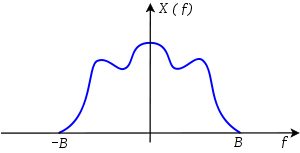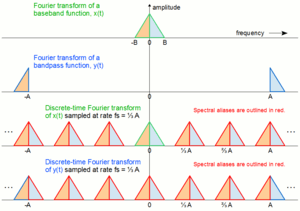Nyquist rate

In signal processing, the Nyquist rate, named after Harry Nyquist, is twice the bandwidth of a bandlimited function or a bandlimited channel. This term means two different things under two different circumstances:
- as a lower bound for the sample rate for alias-free signal sampling[1] (not to be confused with the Nyquist frequency, which is half the sampling rate of a discrete-time system) and
- as an upper bound for the symbol rate across a bandwidth-limited baseband channel such as a telegraph line[2] or passband channel such as a limited radio frequency band or a frequency division multiplex channel.
Nyquist rate relative to sampling
When a continuous function, x(t), is sampled at a constant rate, fs samples/second, there is always an unlimited number of other continuous functions that fit the same set of samples. But only one of them is bandlimited to ½ fs cycles/second (hertz),[note 1] which means that its Fourier transform, X(f), is 0 for all |f| ≥ ½ fs. The mathematical algorithms that are typically used to recreate a continuous function from samples create arbitrarily good approximations to this theoretical, but infinitely long, function. It follows that if the original function, x(t), is bandlimited to ½ fs, which is called the Nyquist criterion, then it is the one unique function the interpolation algorithms are approximating. In terms of a function's own bandwidth (B), as depicted above, the Nyquist criterion is often stated as fs > 2B. And 2B is called the Nyquist rate for functions with bandwidth B. When the Nyquist criterion is not met (B > ½ fs), a condition called aliasing occurs, which results in some inevitable differences between x(t) and a reconstructed function that has less bandwidth. In most cases, the differences are viewed as distortion.

Intentional aliasing
Figure 2 depicts a type of function called baseband or lowpass, because its positive-frequency range of significant energy is [0, B). When instead, the frequency range is (A, A+B), for some A > B, it is called bandpass, and a common desire (for various reasons) is to convert it to baseband. One way to do that is frequency-mixing (heterodyne) the bandpass function down to the frequency range (0, B). One of the possible reasons is to reduce the Nyquist rate for more efficient storage. And it turns out that one can directly achieve the same result by sampling the bandpass function at a sub-Nyquist sample-rate that is the smallest integer-sub-multiple of frequency A that meets the baseband Nyquist criterion: fs > 2B. For a more general discussion, see bandpass sampling.
Nyquist rate relative to signaling
Long before Harry Nyquist had his name associated with sampling, the term Nyquist rate was used differently, with a meaning closer to what Nyquist actually studied. Quoting Harold S. Black's 1953 book Modulation Theory, in the section Nyquist Interval of the opening chapter Historical Background:
- "If the essential frequency range is limited to B cycles per second, 2B was given by Nyquist as the maximum number of code elements per second that could be unambiguously resolved, assuming the peak interference is less half a quantum step. This rate is generally referred to as signaling at the Nyquist rate and 1/(2B) has been termed a Nyquist interval." (bold added for emphasis; italics from the original)
According to the OED, Black's statement regarding 2B may be the origin of the term Nyquist rate.[3]
Nyquist's famous 1928 paper was a study on how many pulses (code elements) could be transmitted per second, and recovered, through a channel of limited bandwidth. Signaling at the Nyquist rate meant putting as many code pulses through a telegraph channel as its bandwidth would allow. Shannon used Nyquist's approach when he proved the sampling theorem in 1948, but Nyquist did not work on sampling per se.
Black's later chapter on "The Sampling Principle" does give Nyquist some of the credit for some relevant math:
- "Nyquist (1928) pointed out that, if the function is substantially limited to the time interval T, 2BT values are sufficient to specify the function, basing his conclusions on a Fourier series representation of the function over the time interval T."
See also
- Sampling (signal processing)
- Nyquist–Shannon sampling theorem
- Nyquist frequency — The Nyquist rate is defined differently from the Nyquist frequency, which is the frequency equal to half the sampling rate of a sampling system, and is not a property of a signal.
- Nyquist ISI criterion
Notes
- ↑ The factor of ½ has the units cycles/sample (see Sampling and Sampling theorem).
References
- ↑ Yves Geerts; Michiel Steyaert & Willy Sansen (2002). Design of multi-bit delta-sigma A/D converters. Springer. ISBN 1-4020-7078-0.
- ↑ Roger L. Freeman (2004). Telecommunication System Engineering. John Wiley & Sons. p. 399. ISBN 0-471-45133-9.
- ↑ Black, H. S., Modulation Theory, v. 65, 1953, cited in OED